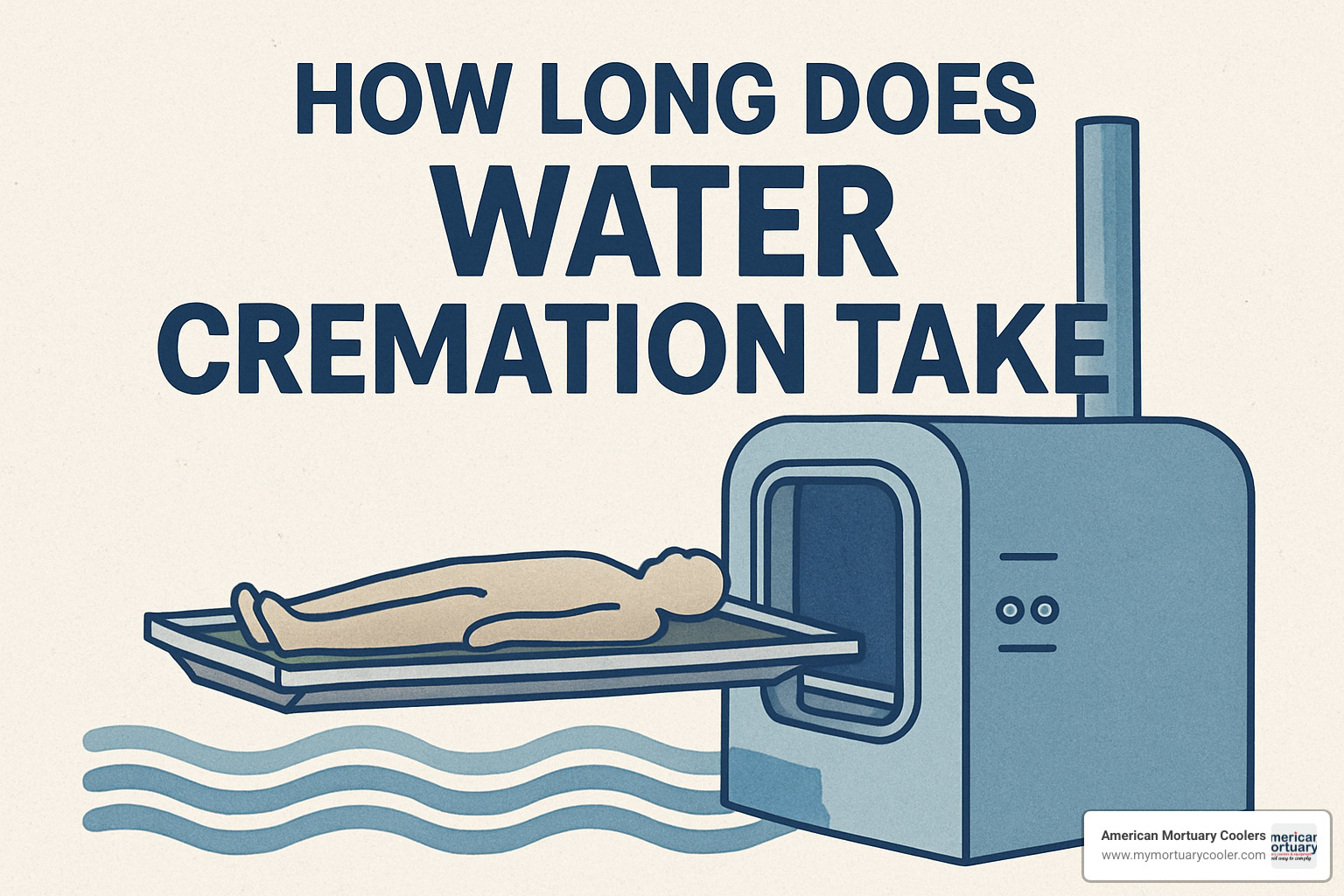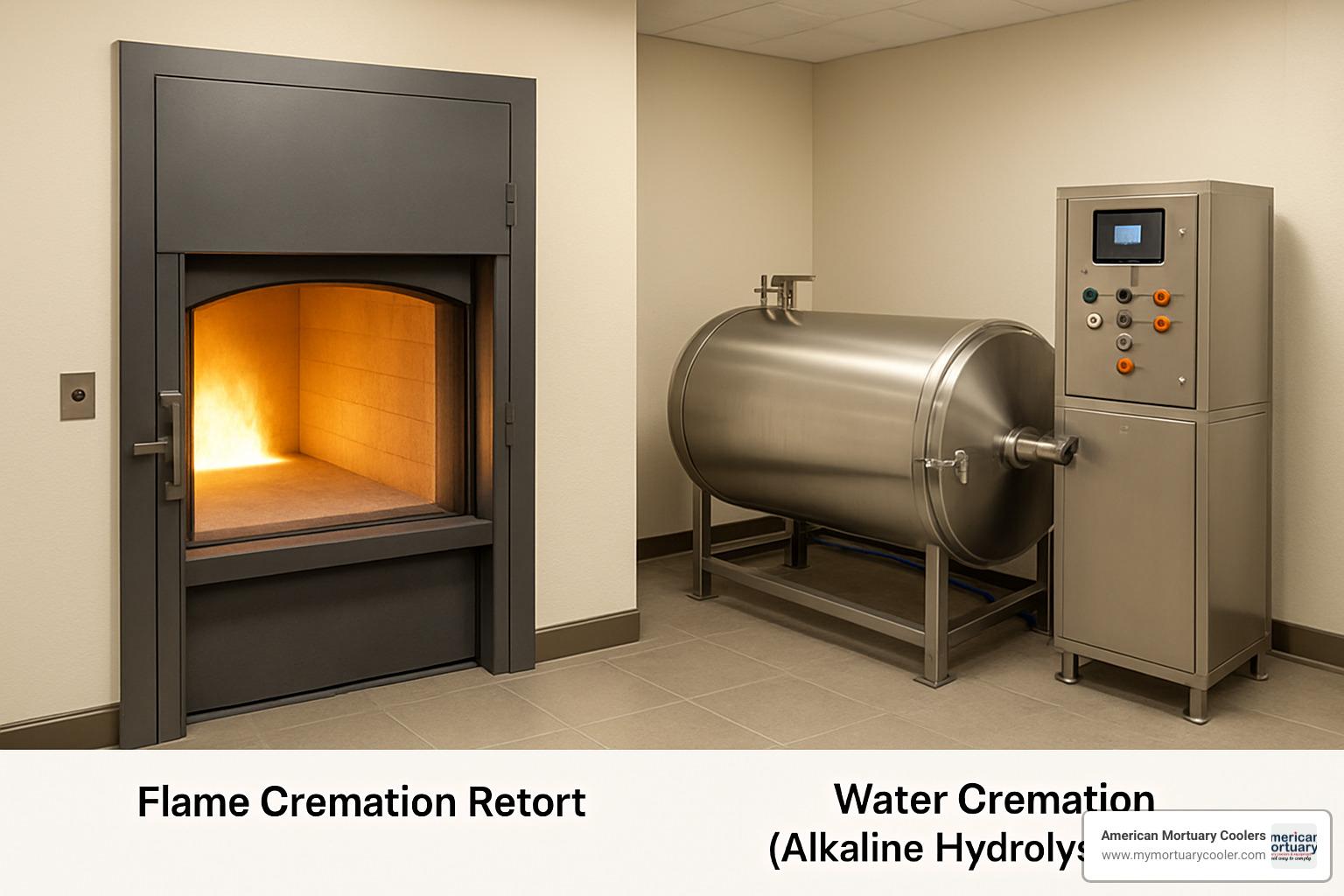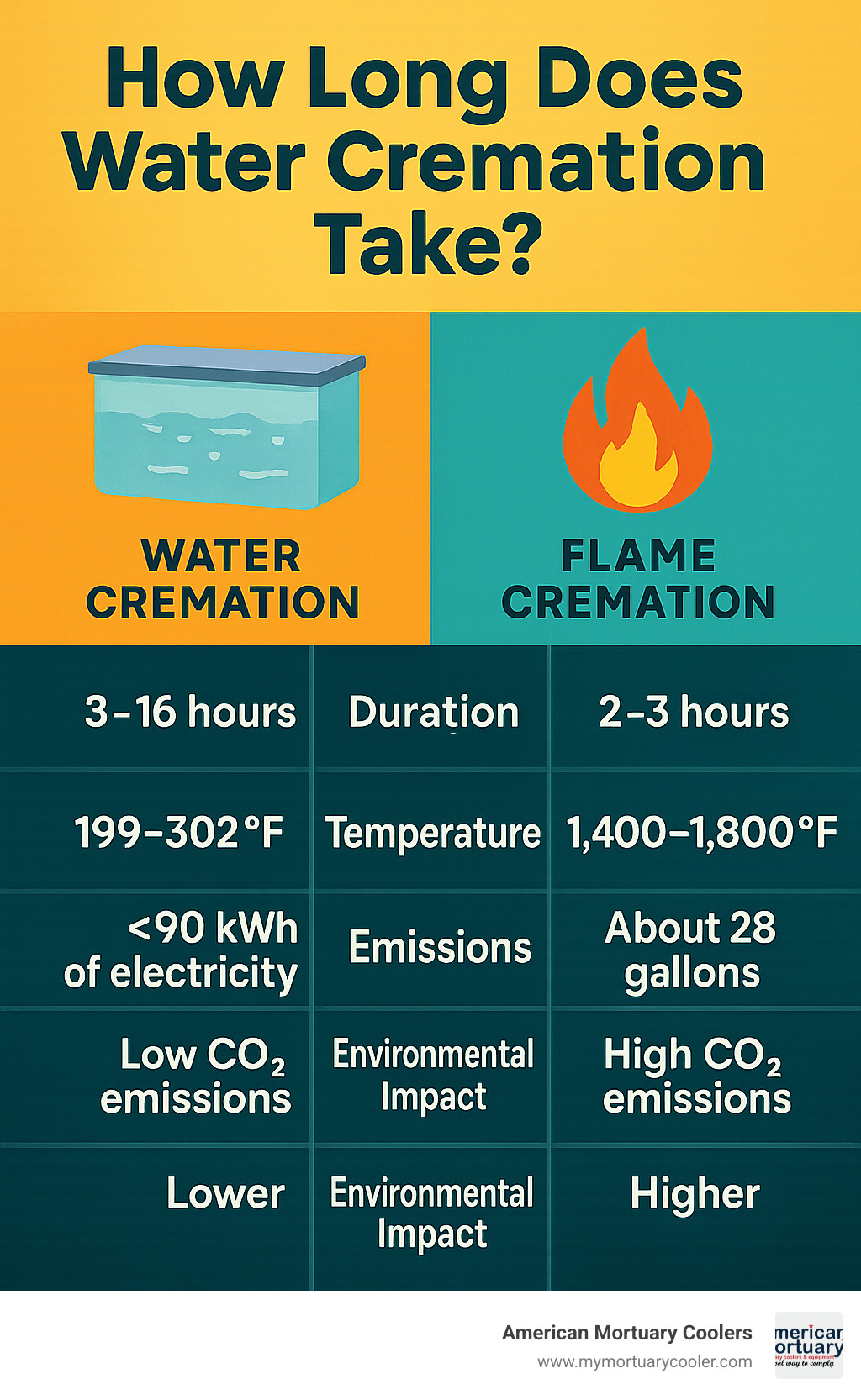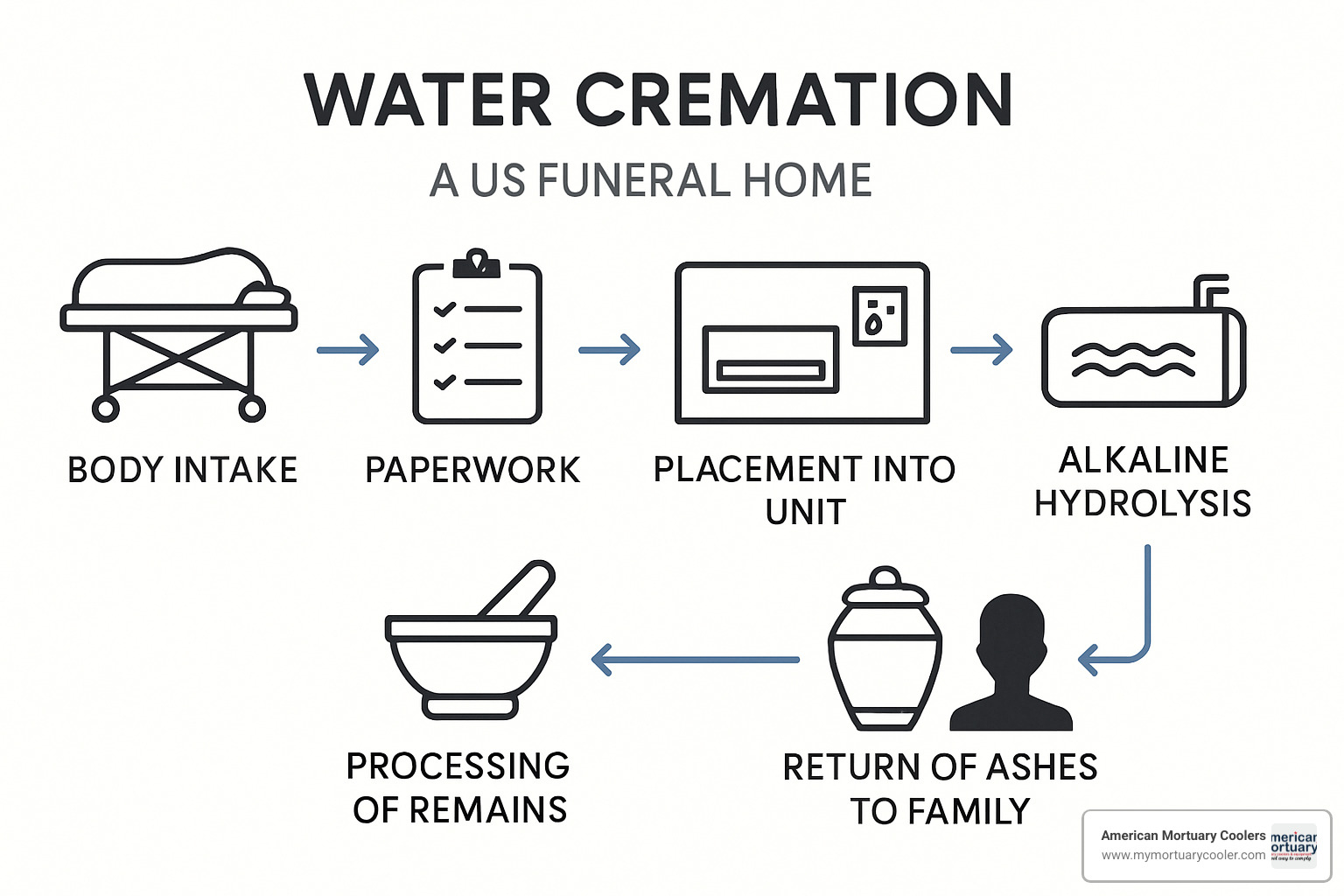Why Understanding Water Cremation Duration Matters for Your Funeral Home
How long does water cremation take is one of the most common questions funeral directors face when considering alkaline hydrolysis services. The process typically takes 3-16 hours depending on temperature settings and body mass, with high-temperature cycles (160°C) completing in 4-6 hours and low-temperature cycles (98°C) requiring 14-20 hours.
Quick Answer: Water Cremation Duration
- High-temperature cycle (160°C): 4-6 hours
- Low-temperature cycle (98°C): 14-20 hours
- Total timeline including prep: 1-2 days
- Bone drying period: 24-72 hours additional
- Energy consumption: ~90 kWh (25% of flame cremation)
Unlike flame cremation's consistent 2-3 hour timeframe, water cremation duration varies significantly based on equipment settings, body composition, and local regulations. This variability often catches funeral directors off-guard, leading to scheduling conflicts and disappointed families.
Understanding these timing factors becomes crucial as more families choose this eco-friendly alternative. Archbishop Desmond Tutu's choice of water cremation brought widespread attention to the process, and funeral homes nationwide report growing demand for this gentle, environmentally conscious option.
As American Mortuary Coolers, we've helped dozens of funeral homes steer the transition to water cremation services, with timing and scheduling being the most frequent concern directors raise about how long does water cremation take. Our experience shows that proper planning prevents most duration-related mistakes that can disrupt your operations.

How Long Does Water Cremation Take? Core Numbers Explained
When families ask how long does water cremation take, the answer isn't as straightforward as traditional flame cremation. The alkaline hydrolysis process runs anywhere from 3 to 16 hours depending on which temperature setting your equipment uses.
Here's the reality: water cremation trades speed for environmental benefits. While flame cremation consistently takes 2-3 hours, water cremation requires more patience. But families choosing this option usually appreciate the gentler approach, even if it means waiting a bit longer.
The process itself is surprisingly efficient with energy. Water cremation uses about 90 kWh of electricity - roughly 75% less energy than flame cremation. That's like running a household for about three days, compared to the massive gas consumption of traditional retorts.
During the cycle, the body rests in a sealed stainless steel chamber filled with 95% water and 5% alkali solution (usually potassium hydroxide). Heat and gentle pressure do the work that flames accomplish in traditional cremation. The pH starts around 14 and gradually drops to 11 as the process completes - a helpful indicator for operators monitoring progress.
Once the main cycle finishes, you're not quite done yet. Bone fragments need 24-72 hours of drying time before they can be processed into the final ash that families receive. This additional step often surprises funeral directors new to water cremation, but it's essential for proper ash preparation.
The entire process eliminates DNA completely and destroys all pathogens, creating a sterile end product. Scientific research on alkaline hydrolysis duration confirms these timelines hold consistent across different equipment manufacturers.
How long does water cremation take at 160°C?
High-temperature water cremation finishes in 4-6 hours when operating at 160°C (320°F). This faster option uses pressure similar to a large pressure cooker - about 60 PSI - to prevent the water from boiling away.
The pressurized environment speeds up the chemical breakdown significantly. Think of it like cooking a roast in a pressure cooker versus a slow cooker - same end result, much faster timeline. The rapid DNA breakdown happens because the higher temperature and pressure create ideal conditions for the alkaline solution to work efficiently.
This approach works well for funeral homes with busy schedules. You can start a cycle in the morning and have it complete by afternoon, making scheduling much more predictable. The equipment does cost more upfront, and operators need proper training to handle pressurized systems safely.
Most families appreciate the faster turnaround when they're planning services. The pressurized chamber ensures complete pathogen elimination while maintaining the gentle nature that draws people to water cremation in the first place.
How long does water cremation take at 98°C?
Low-temperature cycles take 14-20 hours to complete at 98°C (208°F). This approach runs at normal atmospheric pressure, making it simpler to operate but requiring much more patience.
The extended run-time allows for gentler processing that closely mimics natural decomposition, just dramatically accelerated. Universities like the University of Florida have used this method since the mid-1990s, proving its reliability over decades of use.
Many funeral directors run these gentle process cycles overnight to avoid tying up equipment during business hours. The longer timeline actually works in your favor if you plan ahead - start the cycle when you close for the day, and it's ready when you arrive the next morning.
The equipment costs less initially since you don't need pressure vessels or complex safety systems. Maintenance stays simpler too, which appeals to funeral homes wanting to add water cremation without major operational changes.
While the timeline stretches longer, families often find comfort knowing their loved one experienced the most gentle option available. It's a trade-off between speed and the peaceful nature of the process.
Key Variables That Alter Duration

When funeral directors ask us how long does water cremation take, we always follow up with our own question: "It depends - tell me about your specific situation." That's because several key factors can swing processing time by hours, and understanding these variables helps you set realistic expectations with families.
Body mass plays the biggest role in determining cycle length. A petite 120-pound person will process much faster than someone weighing 300 pounds - it's simple physics. The more tissue present, the longer the alkaline solution needs to work. But here's where it gets interesting: body composition matters even more than total weight.
Adipose tissue breaks down differently than lean muscle mass. Bodies with higher fat content often process faster because fat dissolves more readily in the alkaline solution. Meanwhile, very muscular individuals or those with dense bone structure may need extended cycle times. This is why experienced operators learn to adjust their estimates based on visual assessment.
The alkalinity level of your solution directly impacts speed. Most systems use a 5% concentration of potassium hydroxide, but even small variations can add or subtract hours from your cycle. Too weak, and you're looking at extended processing times. Too strong, and you risk equipment damage or safety issues.
Equipment design makes a huge difference in modern water cremation. Newer systems with built-in agitation mechanisms can reduce processing time by 20-30% compared to older static chambers. The gentle movement helps distribute heat and chemicals evenly, ensuring complete tissue breakdown without hot spots or incomplete processing.
Agitation speed and patterns require a delicate balance. Too aggressive, and you risk damaging delicate bone structures. Too gentle, and you extend processing time unnecessarily. The best systems use programmable cycles that adjust agitation throughout the process.
Don't forget about legal hold periods that vary by state. Some jurisdictions require 24-48 hour waiting periods before you can begin the process, which extends your overall timeline from death to ash return. This regulatory requirement often catches new operators off-guard when planning schedules.
Operator training and experience can't be overstated. A skilled technician who understands how to read the signs and adjust parameters can optimize cycle times while maintaining quality results. We've seen inexperienced operators add unnecessary hours to cycles simply because they don't know what to look for.
For a complete walkthrough of optimizing these variables, check out our detailed guide on how to understand the water cremation process in 5 simple steps. Understanding these factors helps you deliver consistent, predictable service that families can count on during difficult times.
Water vs. Flame: Timing & Eco Impact

When families ask how long does water cremation take compared to traditional flame cremation, they're often surprised by the trade-offs involved. Flame cremation runs like clockwork - almost always 2-3 hours from start to finish. Water cremation, on the other hand, takes 3-16 hours depending on your temperature settings.
The reason for this timing difference becomes clear when you look at the temperatures involved. Water cremation operates at a gentle 300°F (160°C), while flame cremation blazes away at 1,800°F (982°C). It's like comparing a slow cooker to a blast furnace - both get the job done, but one takes considerably longer.
Here's where it gets interesting from an environmental standpoint. That lower temperature means water cremation uses about 90 kWh of electricity compared to flame cremation's 28 gallons worth of natural gas or propane. When you crunch the numbers, water cremation uses roughly one-quarter of the total energy.
The CO₂ output tells an even more compelling story. A single flame cremation pumps out an average of 534.6 pounds of CO₂ into the atmosphere. Water cremation's electrical usage results in significantly lower emissions - the exact amount depends on how your local power grid generates electricity, but it's typically around 10 times less CO₂.

Then there's the mercury emissions issue that many funeral directors don't think about. Those old dental fillings release mercury vapor during flame cremation, sending it straight into the air we all breathe. Water cremation keeps everything contained in the sealed chamber - no mercury escaping anywhere.
The liquid that remains after water cremation is completely sterile and safe for standard wastewater treatment. It's essentially the same as what would result from natural decomposition, just accelerated and contained.
From a practical standpoint, the longer processing time can complicate your scheduling. You can't just block out a 3-hour window like you would for flame cremation. But many funeral homes find that families who choose water cremation understand they're making an environmental choice, and they're typically patient with the extended timeline.
The key is setting expectations upfront and planning your workflow accordingly. Most families appreciate the gentler process and environmental benefits once they understand the trade-offs involved.
For a deeper dive into why more families are making this choice, check out our analysis on making waves: why water cremation might be the better choice.
Step-by-Step Timeline & Mistake-Proof Checklist

Walking through the complete timeline helps funeral directors understand exactly how long does water cremation take from start to finish. After helping dozens of funeral homes implement water cremation services, we've seen the same scheduling mistakes happen repeatedly - and they're all preventable with proper planning.
The entire process from body transfer to returning cremains to the family typically takes one week or less. However, the actual timeline depends heavily on your preparation procedures and equipment settings.
The journey begins with transfer and paperwork, which can take anywhere from a few hours to 24 hours. This phase includes body transfer to your facility, securing required permits and authorizations, and completing pre-cremation preparation. Unlike flame cremation, you'll spend time identifying medical devices - though most don't actually need removal before water cremation.
The chamber cycle represents the heart of the process, taking between 3-16 hours depending on your temperature settings. During this phase, the body is placed in the alkaline hydrolysis chamber, the water and alkali solution is prepared and added, and heat and pressure are applied. Your staff will monitor the process and handle solution drainage once the cycle completes.
Bone rinsing and drying requires the most patience, extending 24-72 hours after the main cycle. The bone fragments receive thorough rinsing, followed by air drying or controlled drying processes. This stage also includes quality inspection and metal recovery for recycling. Rushing this phase creates the most common quality problems we see.
Ash processing moves quickly once the bones are properly dried, typically taking about one hour. The bone fragments are reduced to fine powder, weighed, and packaged in temporary or permanent containers. Final documentation and chain of custody procedures wrap up this stage.
Returning cremains to families usually happens within the same week as the original transfer. This involves completing final paperwork, scheduling pickup or delivery, and coordinating with family members.
The biggest mistakes we see funeral directors make center around implant removal confusion. Many operators delay the process unnecessarily to remove pacemakers and medical devices that don't actually require removal before water cremation. Temperature mis-settings can double your processing time, while pH imbalances from incorrect alkali concentrations extend cycles significantly. Inadequate drying time leads to poor-quality cremains, and scheduling conflicts from not accounting for variable processing times create disappointed families and operational stress.
The key to avoiding these pitfalls lies in building buffer time into your scheduling and verifying equipment settings before beginning each cycle. Monitor pH levels throughout the process and resist the temptation to rush the bone drying phase.
For comprehensive process guidance that covers each step in detail, review our guide on aqua cremation explained: a water-based alternative.
Frequently Asked Questions About Water Cremation Time
Does water cremation always take longer than flame cremation?
This is one of the most common questions we hear from funeral directors, and the answer might surprise you. While how long does water cremation take usually exceeds traditional flame cremation, the gap isn't as wide as many people think.
High-temperature water cremation cycles complete in 4-6 hours compared to flame cremation's standard 2-3 hours. When you factor in the total processing time - including preparation, cooling periods, and post-processing - the difference becomes much less significant.
The real difference lies in predictability. Flame cremation runs like clockwork, taking 2-3 hours regardless of whether you're processing a 120-pound individual or someone weighing 300 pounds. Water cremation, on the other hand, varies based on body composition, equipment settings, and operator experience.
This variability requires more flexible scheduling, but many families find the environmental benefits worth the extra planning. Plus, the gentler nature of the process often brings comfort to grieving families who appreciate the less harsh approach.
Can larger bodies extend how long water cremation takes?
Absolutely, and this is where understanding your equipment becomes crucial. Body mass can increase processing time by 20-30%, especially in low-temperature systems running at 98°C.
But here's what's interesting - total weight matters less than body composition. Someone with higher adipose tissue content may require longer processing time than a larger person with more lean muscle mass. Experienced operators learn to estimate cycle times by considering both factors together.
Modern equipment helps minimize these variations. Systems with improved circulation and agitation can handle larger bodies more efficiently than older static chambers. The key is working with equipment manufacturers who understand these nuances and can help you optimize your settings.
At American Mortuary Coolers, we've seen funeral homes struggle with this initially, then master the timing as they gain experience. It's all about understanding your specific equipment and building realistic expectations into your scheduling.
How soon will my family receive the remains?
This question touches the heart of why timing matters so much in our industry. Most families receive their loved one's cremains within 10-14 days of the initial service, though several factors influence this timeline.
The cycle completion takes 3-16 hours depending on your temperature settings, but that's just the beginning. Bone drying requires 24-72 hours for proper moisture removal - and rushing this step compromises the quality of the final cremains.
Processing the dried bones into fine ash takes another 1-2 hours, plus you'll need 1-3 days for administrative tasks like paperwork completion and scheduling coordination with the family.
Here's something families often appreciate: water cremation typically yields 20-30% more cremains than flame cremation. The remains are also whiter and finer in texture because there's no carbon discoloration from burning. Many families find this more appealing for memorial purposes.
The key to managing family expectations is clear communication upfront. When families understand the process takes longer but produces higher-quality results with environmental benefits, most are happy to wait the extra few days.

Conclusion
Planning for how long does water cremation take doesn't have to feel overwhelming. Yes, the 3-16 hour processing time is longer than flame cremation's predictable 2-3 hours, but thousands of funeral homes have successfully made this transition by understanding the variables and planning accordingly.
The timing differences actually work in your favor once you establish clear processes. High-temperature systems complete cycles in 4-6 hours - not drastically different from traditional methods when you factor in cooling time. Low-temperature systems take 14-20 hours, but many operators run these overnight cycles, making the extended duration less disruptive to daily operations.
What we've learned from helping funeral directors across the country is that families appreciate transparency about timelines. When you explain that water cremation takes a bit longer because it's gentler on their loved one and the environment, most families gladly accept the extra day or two.
At American Mortuary Coolers, we've watched this industry shift toward more sustainable practices over our years serving Tennessee and the broader funeral community. The families choosing water cremation aren't just thinking about today - they're considering the world they're leaving behind.
The learning curve for how long does water cremation take becomes second nature within a few months of operation. Equipment manufacturers continue improving efficiency, and operator experience reduces the variables that once made scheduling challenging. Your investment in understanding these timing factors positions your funeral home as a forward-thinking leader in eco-conscious services.
The funeral industry is evolving, and water cremation represents more than just an alternative process - it's a bridge to a more environmentally responsible future. By mastering the timing aspects now, you're preparing your business for the growing demand from environmentally conscious families.
Ready to explore the financial aspects of adding water cremation services? Our detailed analysis in the price of peace: understanding alkaline hydrolysis costs breaks down everything you need to know about implementing this service in your funeral home.
















